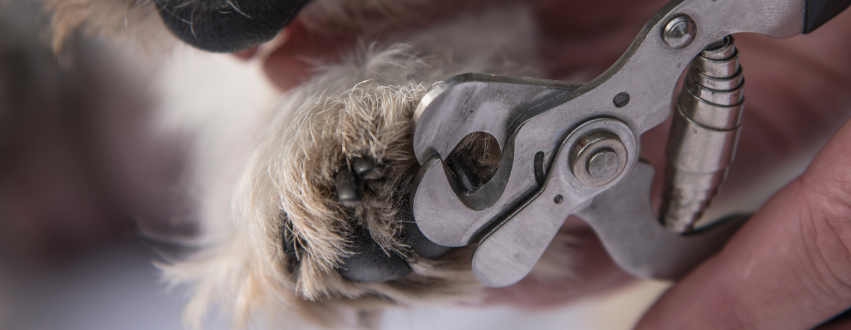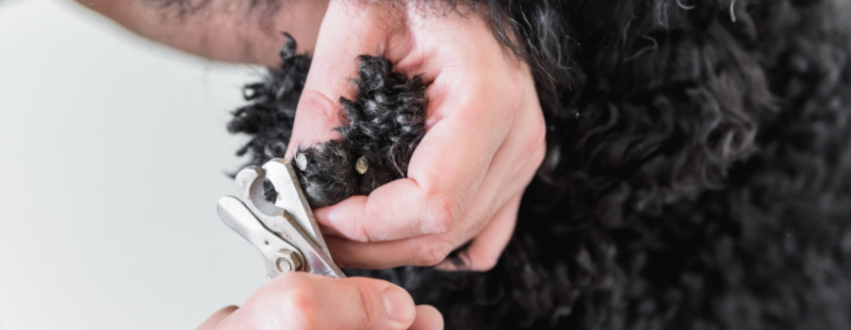Just like us, our dog's nails grow and sometimes need a little pampering to keep them looking their best. Cutting a dog’s nails is more than just cosmetic, nails that are too long are more likely to get caught in things, break, or get infected.
Ideally, try to make sure your dog gets plenty of walks across hard surfaces like pavements, this will help to wear down their claws and keep them at a good length. However, sometimes nails aren’t worn down as quickly as they grow and will need trimming, it’s good practice for a dog owner to regularly check their length to stop any problems that may arise with long claws. However, you may be wondering how to cut your dog’s claws. In this blog, we look at exactly how to trim your dog’s nails, how to encourage your dogs to have their nails cut and how to know when your dog’s claws need cutting.
Can I Clip My Dog’s Claws

Yes, you can cut your dog’s claws yourself or if you’d be more comfortable both your vet and groomer are also able to cut your dog’s claws.
Before cutting your dog’s claws it’s important to know the signs of when they are too long. A good way of knowing when your dog’s claws need clipping is to hold their paw in the palm of your hand, if the nails touch your hand they may be too long. Other signs that their nails may be too long are if they are licking or chewing their paws more than normal or if you hear the click of their nails as they walk.
When cutting your dog’s claws, it’s important not to cut too close to the quick, this is at the centre of the nail and contains their blood vessels and nerves. Ideally, when trimming their claws, you want to stay 3-4 mm away from the quick.
If you have a new puppy, try getting them used to having their paws handled and their claws touched so that when they eventually need their claws trimming it will hopefully be a slightly easier process for both you and them.
Below we’ve put together our top tips on how to trim a dog’s claws to make the process as easy as possible
How To Trim Dog Claws

- Make sure you have a good pair of dog nail clippers, our favourites are the Ancol Ergo Nail Clippers, they come in two sizes, so you’ll be able to find the best fit for your breed. If you have a nervous dog a file can work best. Help keep your dog in a good mood by having plenty of treats to hand, this can work as a rewards-based training opportunity for them and will help to keep them loving having their nails trimmed. The silicone wall mats with dog peanut butter are a great way of keeping your dog busy whilst you take care of their nails.
- Start by holding their paw, you will need to hold it firmly yet gently with a thumb on the pad of their toe and your forefinger on the top just above the nail. If you need more visibility of the claw, try flexing their pads and make sure any fur is out the way.
- Position your clippers over the claw, most will have a guard to stop you from taking too much off. Begin by cutting the tips of their claws and then check where the quick of their claw is before deciding if any more needs removing. The length of the quick varies from dog to dog so there’s no set rule on how long this will be, but you can tell by when their nail curves – dogs with dark nails may have a chalky white ring where it’s safe to cut, other nail colours may also change in colour where the quick ends. But if you’re unsure just trim little by little to be safe
- Repeat the process across all their claws, and make sure you check their dew claws as well. You’ll find these on the inside of their leg higher up.
How To Stop Dog’s Claw Bleeding
If you’ve accidentally cut their claw too short or if your dog has happened to catch their nail don’t worry, nails can bleed a lot but often are nothing to worry about for a healthy dog. Contact your vet straight away for advice.
To prevent any infections, you’ll want to stop the bleeding and cover the claw. For this we recommend the Aqueos Spray on Plaster or a bandage, this is good as a temporary solution until you can get to your vet. It’s always a good idea to keep a pet first aid kit in your cupboard for any unexpected injuries your dog may get. We particularly love the Charlie The Vet First aid kits, they're perfect for keeping on hand in case there's any emergencies!
How To Get Your Dog Comfortable Having Their Nails Trimmed.

Not all dogs are quite so well behaved when having their nails cut, here patience is key. Slowly reintroducing them to having their nails trimmed may help get your dog used to having their nails cut.
- Show your dog the nail clipper and let them sniff it, make sure to treat and praise them.
- Tap each paw lightly with the nail clippers then treat and praise them.
- Touch the nail clippers to your dog’s paws again, making sure there is plenty of treats and praise – repeat this until they don’t seem more comfortable or unfazed by the process.
- Once they are comfortable with having their claws tapped with the clippers try trimming the tiniest tip off one of their front paw claws. Only do one claw and make sure to offer praise and treats. Repeat one nail a day until they don’t seem to mind.
- Once they are comfortable with one nail try two and keep working your way up until you can do them all.
TIP – practice even when their nails don’t need cutting, you can pretend and go through the motions to help get them used to the process so that when next time their claws do need cutting the whole process isn’t quite as scary for them.
If you’re still unsure about cutting your dog’s nails speak to your vet or groomer, they will be either able to talk you through it and give some great advice or trim your dog’s nails for you.





























































































